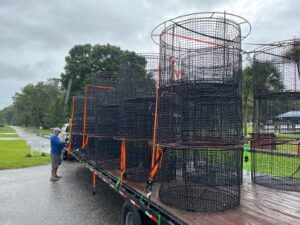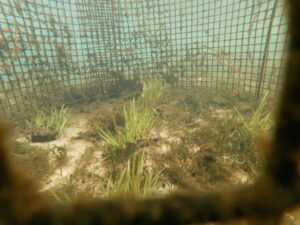IT'S ALL ABOUT THE GRASS
It may be all about the grass but first a clean substrate is necessary to plant and that is why we vacuum dredge. Removing years of nutrient laden muck and detrital material exposing the sand and gravel base optimal for root growth. Grass is the key component of the Homosassa River Restoration Project. Grass cleans the water, stabilizes sediments, provides food and habitat for fish and animals, and helps remove harmful nutrients. Healthy grass beds will change an algae-dominated water body into a beautiful, clean, clear, sustainable plant based ecosystem. Grass units planted last October are taking root and beginning to spread. Sea & Shoreline biologists concentrated on the main riverbed on the east side of the Fishbowl Drive Bridge (Area A) and we are seeing the rewards of their efforts. Despite the negative pressures of people and manatee's lateral growth has been better than expected in a good portion of areas planted. Small colonies of grass have also started to migrate and root downstream as well.
In the spring of this year Area "B" was planted along with Area "C" in June. This past week Area "D" was planted and marked the beginning of the use of herbivore exclusion cages.
Grass units planted last October are taking root and beginning to spread. Sea & Shoreline biologists concentrated on the main riverbed on the east side of the Fishbowl Drive Bridge (Area A) and we are seeing the rewards of their efforts. Despite the negative pressures of people and manatee's lateral growth has been better than expected in a good portion of areas planted. Small colonies of grass have also started to migrate and root downstream as well.
In the spring of this year Area "B" was planted along with Area "C" in June. This past week Area "D" was planted and marked the beginning of the use of herbivore exclusion cages.
 In Area "D" alone there were 119 herbivory cages, 595 4" potted plant units, and 6,215 mechanical plant units installed. To date biologists have installed 28,920 individual plant units in Area's "A" through "D"
In Area "D" alone there were 119 herbivory cages, 595 4" potted plant units, and 6,215 mechanical plant units installed. To date biologists have installed 28,920 individual plant units in Area's "A" through "D"
EXCLUSION CAGES
What are they and why do we use them? Manatee's eat grass. They eat a lot of grass and that includes ours. As long as the grass blades are chewed off near the bottom, similar to cattle grazing on a pasture, no problem. An issue arises if the grass root systems are not strong enough to keep the grass from being completely dislodged. People walking along the bottom can cause similar problems. Herbivory cages help protect young grasses until they are able to establish root systems strong enough to withstand a hungry manatee. FWC regulates when and how we can use underwater devices and until now there was insufficient water depth to use the cages. The cages are kept in place for 1 to 2 years and have to be cleaned regularly.
CHANGE COMES SLOWLY
It has taken many years of steady decline to reach where this river is today. Restoration projects of this magnitude do not occur overnight. The Homosassa River is still algae dominant but as the grass beds expand they will slowly drive out the Lyngbya. Floating mats of Lyngbya will, and have, moved back into area's already cleaned and planted. It makes it hard to see the grass but it is there developing strong root systems and spreading out. Grasses have begun to develop some height as well. Maintenance of these previously cleaned and planted sections will begin soon. This periodic maintenance is important until the grasses gain a foothold over the Lyngbya.
HOW YOU CAN HELP
Spread the word!! Anchors and props damage grasses. Try and watch where you stand if enjoying a day in the headwaters. Just like your lawn, aquatic grasses can be destroyed by too much foot traffic. Continue to follow us on Facebook and this website Homosassa River Restoration Project.com.
Continue to follow us on Facebook and this website Homosassa River Restoration Project.com.

